inlifethrill.com posts a quick little tip for creating double sided shaders for objects in Cinema 4D. This is a great technique for texturing single sided objects, such as paper, or a leaf or anything that has no or little thickness to it at all.
By using the Layer Shader, you are able to get a more elegant solution
Typically, having two textures display on either side of an object can easily be done by setting the texture tag so that one will show on the front, and set the other texture to show up on the back. There is nothing wrong with that system, however, inlifethrill shows a way that is a bit cleaner.
By using the Layer Shader to create a double sided shader, you are able to get a more elegant solution. By loading both textures inside the C4D Layer Shader, as well as a layer for the normal direction you are able to set both textures for the object. the normal direction will dictate which texture will be seen on which side.
Creating a double sided shader this way will not only use less texture tags for the object, but it can open up some new creative possibilities as well. By changing the blend mode for the layers, you can have fine control over how the textures display and where, as shown in the tutorial.
Going Further with The C4D Layer Shader
There have been previous posts that had a look at incorporating the layer shader in C4D into texturing workflow, notably Biscuits and Davey with a post that showed how to use the Layer Shader with Alpha channels to create more complex textures for your objects: Using The Layer Shader and Alpha Channels for Materials Cinema 4D.
Ben Watts Design showed how to put the Layer Shader to good use and demonstrated how to burn a sheet of paper realistically with the post: Creating Multi-Layerd Material to Animate a Burning Piece of Paper.
Dan Conrad shows a common practical use for the layer shader in creating rusted and worn out materials in the post Rendering and Compositing a Rusted Worn Truck.

